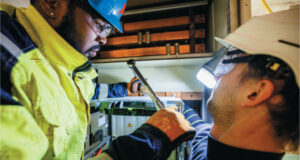TOR IDHAMMAR
Suddenly we are reading about AI (Artificial Intelligence), ML (Machine Learning), Big Data and drones in our maintenance news. Is it like usual—a bunch of new, sponsored terms (and acronyms of course)? Or is the whole industry about to change and put us all at risk of losing our jobs?
The industry is changing, and we will lose our jobs—at least the jobs we have now.
Many of us can’t keep up with the changes; not even our imaginations can keep up. It’s hard for us linear thinkers to envision 2030 because technology is developing at such an exponential rate. You know that a 3D printer has just built a 70,000-square-foot house in Dubai, right? And that there are robots capable of laying 1,000 bricks per minute?
The examples are numerous and vivid. Take driverless taxi services: yes, you can now grab a cab without a driver. Waymo (originally “Google self-driving car project”) now has an Uber-like service in Phoenix, AZ, and plans on expanding (www.waymo.com). My advice is to quickly cancel those classes to become a licensed taxi driver and for Pete’s sake, do not invest in car insurance companies!
But flying taxis aren’t here yet, are they? Not quite, but Uber Technologies Inc. says that in 2023 we’ll be able to fly to work (Uber Elevate – www.uber.com). Solar cells that were 21 percent effective a few years ago are soon closer to 66 percent thanks to quantum dots. Around 2025 we will be able to ride Elon Musk’s Hyperloop train at a speed of 750 mph. In summary, we can live in our vacation home and fly to work, sell our cars, dump our car insurance, cut ties with the power company and build our backyard shed with a rented robot!
WHERE DOES R&M COME IN?
So, what does all of that have to do with maintenance? Everything. Several companies IDCON works with have installed vibration and temperature sensors on equipment and are centralizing both process and equipment data with the help of AI. They apply machine learning algorithms to the data with remarkable results. We discover equipment and process problems we never found before and/or earlier than before. In the past, maintenance workers inspected equipment “manually” and interpreted the data from a maintenance perspective. Operations folks read process data from their perspective. Some failures are caught early enough that all damage can be avoided.
For example, it is common to see the AI system catch cavitation the first few seconds it starts. The system reads the inlet flow and pressure, sees the position of the inlet valve, picks up the vibration reading, and then quickly concludes if there are issues with the pump. The operator gets a message from central command and can correct accordingly.
In the mining industry, this concept is nothing new. Rolling stock equipment has been monitored remotely for many years, and now they are also using AI in their inspections and operational data.
My father (recognized reliability and maintenance expert Christer Idhammar) has always said that automation will continue, but maintenance will always be needed since machines need repairs. During his 60-year-long career, this was true. Maybe it will remain true for a while longer, but I don’t think it will last forever. Today we have robots performing heart surgery. They are simply better at it than humans. They know what they are supposed to do, they never have shaky hands, and they have much better vision. If this is the case, why couldn’t a robot repair? Say, tightening a packing or repairing a pump, a 3D printer, or even another robot?
Spare parts stores will disappear. When we need a spare part we will go to the nearest 3D printer and print it out, no inventory needed. Furthermore, could a robot itself bring the part to the 3D printer? This may not happen this decade but…at some point. The technology already exists.
If AI is new to you, I recommend reading up on how Artificial Intelligence and Machine Learning can be applied to maintenance. If you are under 45 it is critical for your career. Personally, I am taking a series of online classes with MIT Management Executive Education along with reading books and articles to increase my understanding of the changes we are facing. I recommend The Future is Faster Than You Think, by Peter Diamandis and Steven Kotler. Many of the factual examples in this article, like Waymo, flying cars, and bricklaying robots, are sourced from this book.
 Paper 360
Paper 360
